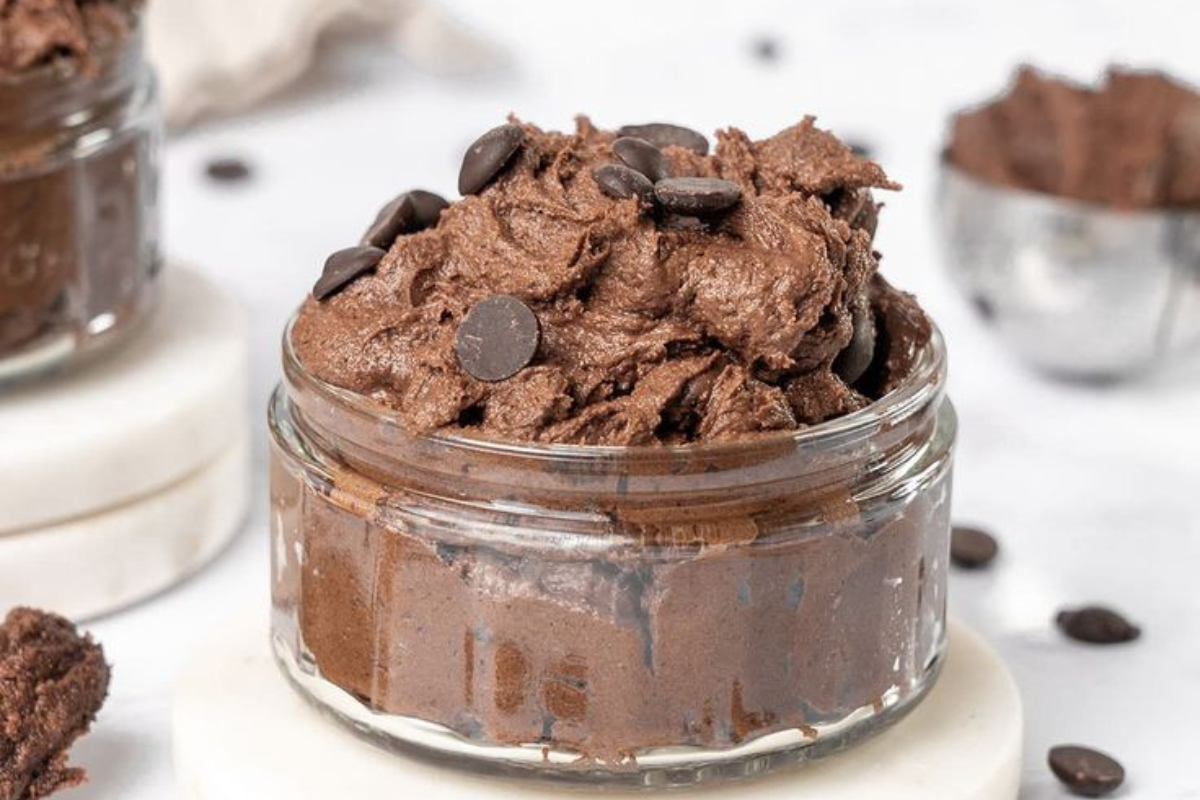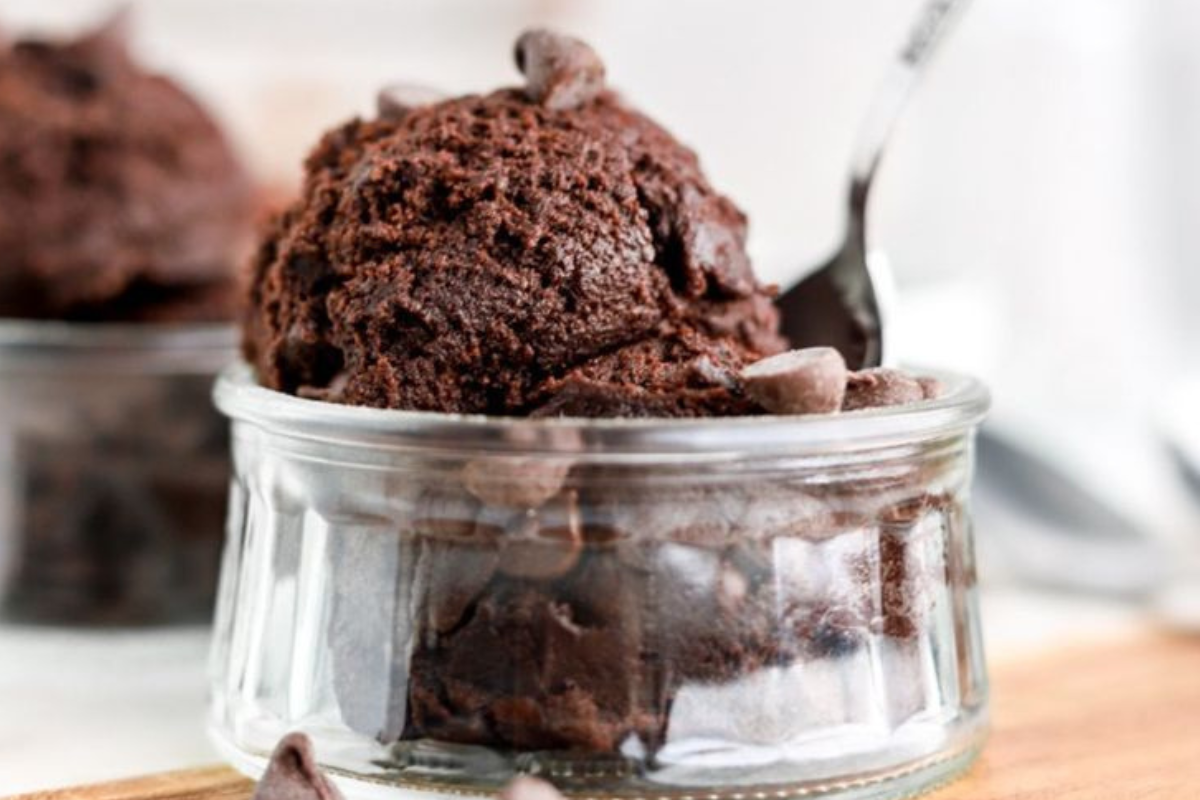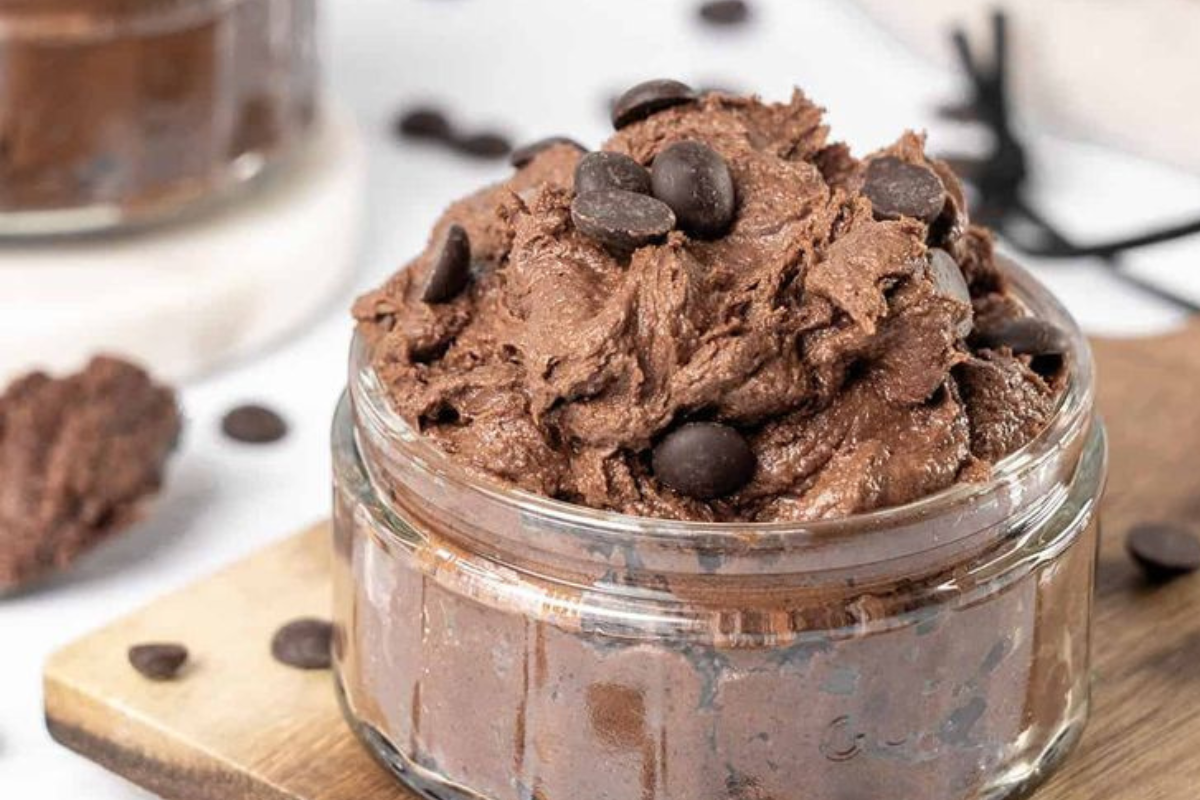Introduction
Edible brownie batter is a delectable treat that caters to the chocolate lover’s ultimate fantasy – enjoying rich, fudgy brownie mix straight from the bowl without any baking. Unlike traditional brownie batter, which contains raw eggs and uncooked flour, edible brownie batter is crafted to be safe and satisfying to eat as is. This delightful concoction usually involves heat-treated flour and omits eggs, thus eliminating the risks associated with consuming raw ingredients. The result is a velvety, chocolate-rich batter that retains all the flavors of traditional brownies but is designed to be enjoyed raw.
This batter often includes all the classic ingredients of a brownie—cocoa powder, sugar, butter, and chocolate chips – and can be customized with various mix-ins like nuts, flavored chips, or candy pieces. The texture ranges from thick and spoonable to creamy and scoopable, depending on the preparation method, making it versatile in its use and presentation.
The Rise in Popularity of Edible Dessert Batters
The trend of edible dessert batters, particularly brownie batter, has gained significant momentum in recent years. With the rising awareness of food safety coupled with a growing penchant for convenience and immediate gratification, more people are turning to edible batters as a quick and safe way to indulge their sweet cravings.
Social media and the internet have played a crucial role in this surge in popularity. Platforms like Instagram, Pinterest, and food blogs are awash with pictures and recipes of edible brownie batter, often styled in appealing ways that encourage sharing and replication. The trend also aligns well with the current consumer preference for nostalgic and comfort foods, harking back to childhood memories of licking the batter off the spoon while baking with family.
Moreover, the versatility and ease of making edible brownie batter have added to its appeal. Whether as a late-night snack, a party dip, or a creative dessert base, it offers endless possibilities for customization and creativity. Its no-bake nature also makes it a quick and easy treat for those without the time or means to bake a full batch of brownies.
In conclusion, edible brownie batter stands as a testament to the evolving world of dessert, where innovation meets tradition, and safety pairs with indulgence. Its rise in popularity not only reflects changing consumer preferences but also showcases the dynamic and creative nature of modern culinary practices.
The Recipe: Ingredients and Steps
Essential Ingredients
To make a basic edible brownie batter, you’ll need the following ingredients:
- All-Purpose Flour (1 cup) heat-treated to make it safe for consumption.
- Unsalted Butter (1/3 cup) melted; adds richness to the batter.
- Granulated sugar (1/2 cup) for sweetness.
- Brown sugar (1/2 cup) adds depth and a hint of caramel flavor.
- Unsweetened Cocoa Powder (1/2 cup): For the classic chocolatey brownie taste.
- Milk (3-6 tablespoons) regular or any plant-based milk to adjust consistency.
- Vanilla Extract (1 teaspoon): Enhances flavor.
- Salt (1/4 teaspoon) balances sweetness.
- Chocolate Chips (optional, 1/4-1/3 cup): For extra chocolate chunks in the batter.
Step-by-Step Recipe Instructions
- Heat Treat the Flour:
- Spread the flour on a baking sheet and bake in a preheated oven at 350°F (175°C) for about 5 minutes. This process eliminates any potential bacteria in the flour.
- Allow the flour to cool down completely before using it in the recipe.
- Prepare the wet ingredients:
- In a medium bowl, melt the butter.
- Add both granulated and brown sugars to the melted butter and whisk until well combined.
- Stir in the vanilla extract.
- Combine dry ingredients:
- In a separate bowl, mix together the heat-treated flour, cocoa powder, and salt.
- Mix Wet and Dry Ingredients:
- Gradually add the dry ingredients to the wet mixture, stirring until well incorporated.
- Add milk, starting with 3 tablespoons, and mix. Continue adding more milk, one tablespoon at a time, until you reach your desired consistency. The batter should be smooth and thick.
- Add chocolate chips (optional):
- If desired, fold in chocolate chips or any other mix-ins like nuts or candy pieces.
- Taste and adjust:
- Give the batter a taste and adjust the sweetness or cocoa intensity as needed. If the batter is too thick, add a little more milk.
- Enjoy!
- Your edible brownie batter is now ready to be enjoyed! Serve it as it is, or use it as a dip with fruits, pretzels, or graham crackers.
This recipe provides a simple and delicious way to safely enjoy brownie batter without the need for baking. You can get creative with the mix-ins and adjustments to suit your taste preferences. Remember, the key to a safe and delicious edible brownie batter is ensuring that the flour is properly heat-treated.
Health and Safety Considerations
Importance of Heat-Treating Flour
- Eliminating Bacteria: Raw flour can harbor harmful bacteria like E. coli, which pose serious health risks if consumed. Heat treating flour is crucial to killing any potential pathogens. This process involves baking the flour at a high enough temperature to ensure it’s safe for raw consumption.
- How to Heat Treat Flour:
- Oven Method: Spread flour on a baking sheet and bake at 350°F (175°C) for about 5 minutes.
- Microwave Method: Place flour in a microwave-safe bowl and heat it in the microwave for 1-2 minutes, stirring every 30 seconds until it reaches an internal temperature of 160°F (71°C).
- Checking the Temperature: Use a food thermometer to check that the flour has reached the safe temperature of 160°F (71°C) to ensure all bacteria are killed.
- Cooling Before Use: Allow the flour to cool completely before using it in your edible brownie batter recipe to prevent it from melting the butter or other ingredients.
Safe Substitutes for Raw Eggs
- Why Avoid Raw Eggs: Raw eggs can contain Salmonella, a bacteria that causes foodborne illness. Since edible brownie batter is meant to be consumed without cooking, it’s essential to avoid using raw eggs in the recipe.
- Substitution Options:
- Milk or cream provides the moisture needed without the health risks associated with raw eggs. Adjust the quantity to achieve the desired consistency.
- Yogurt or sour cream: These can add richness and a slight tang to the batter, mimicking the emulsifying property of eggs.
- Commercial Egg Replacers: These are designed to replicate the binding properties of eggs in baking and are safe to consume raw.
- Recipe Adjustments: When omitting eggs, you may need to adjust other ingredients to achieve the right texture. This might involve experimenting with quantities of milk, butter, or the addition of a binding agent like cornstarch.
By following these health and safety considerations, you can enjoy edible brownie batter without worrying about foodborne illnesses. Heat treating flour and using safe substitutes for raw eggs are simple steps that ensure you can indulge in this treat with peace of mind.

Customizing Your Brownie Batter
Creative Mix-ins and Toppings
- Chocolate Variations:
- Different Chocolate Chips: Experiment with milk, dark, white, or even flavored chocolate chips like mint or caramel.
- Chocolate Chunks: For a more rustic texture, use roughly chopped chocolate bars.
- Nuts and seeds:
- Classic Choices: Walnuts, almonds, or pecans can add a delightful crunch.
- Seeds: For a nut-free option, try sunflower or pumpkin seeds.
- Fruit Add-ins:
- Dried Fruit: Incorporate dried cherries, cranberries, or raisins for a chewy texture.
- Freeze-Dried Fruit: Adds a pop of tartness and vibrant color; think freeze-dried strawberries or raspberries.
- Sweet Treats:
- Candy Pieces: Mix in your favorite candy bars, chopped into small pieces.
- Marshmallows: Mini marshmallows can add a gooey, sweet element.
- Biscuit/Cookie Bits:
- Oreos, Graham Crackers, or Biscotti: Crushed and mixed in for an added layer of flavor and texture.
Flavor Variations
- Spice It Up:
- Cinnamon or nutmeg: A pinch can warm up the flavor.
- Chili Powder: For those who like a little heat with their sweets.
- Coffee Infusion:
- Espresso powder enhances the chocolate flavor and adds a subtle coffee kick.
- Minty Fresh:
- Peppermint Extract: A few drops for a refreshing, minty twist.
- Boozy Batters:
- Liquor Infusion: A splash of rum, bourbon, or Baileys can elevate the batter to a grown-up treat.
- Citrus Zest:
- Orange or Lemon Zest: Adds a bright, aromatic note.
- Salted Caramel:
- Caramel Swirls: Drizzle in salted caramel sauce and gently swirl into the batter.
- Peanut butter or Nutella:
- Swirl In: Add dollops of peanut butter or Nutella and swirl for a nutty, creamy flavor.
These customizations allow you to transform the basic edible brownie batter into a versatile canvas for various flavors and textures. Whether you’re looking for something nutty, fruity, or even a bit adventurous, these mix-ins and flavor variations can cater to any palate, making each batch of brownie batter a new and exciting experience.
Dietary Adjustments
Making Vegan-Friendly Brownie Batter
- Vegan Butter: Replace regular butter with vegan butter or coconut oil for a dairy-free alternative.
- Plant-Based Milk: Use almond milk, soy milk, oat milk, or any other plant-based milk instead of dairy milk.
- Vegan Chocolate: Ensure that the chocolate chips or chunks are dairy-free.
- Vegan Sweeteners: Some sugars are processed with bone char. Opt for certified vegan sugars, to be sure.
- Vegan Flavorings: Check the labels on vanilla extract and other flavorings to ensure they are free from animal-derived ingredients.
Gluten-Free and Low-Sugar Variations
- Gluten-Free Flour: Substitute all-purpose flour with a gluten-free flour blend. Make sure it’s a 1:1 substitution blend for best results. Note that the texture might be slightly different from a wheat flour-based batter.
- Almond or Coconut Flour: These are naturally gluten-free but may require adjustments in quantities due to their different absorption rates compared to regular flour.
- Sugar Alternatives: Replace granulated and brown sugars with lower-glycemic alternatives like coconut sugar, agave nectar, or stevia. Adjust to taste, as these can be sweeter than regular sugar.
- Reduced Sugar Options: Simply reduce the amount of sugar called for in the recipe. You can increase the cocoa powder slightly to maintain the flavor balance.
- Dark Chocolate: Opt for high-cocoa-content chocolate chips or chunks, as they generally contain less sugar.
Tips for Dietary Adjustments
- Texture Adjustments: Gluten-free flours and sugar substitutes can change the texture of your batter. It might take some experimentation to get your desired consistency.
- Flavor Testing: When making substitutions, especially with sweeteners, taste as you go and adjust accordingly.
- Allergen Awareness: Always read labels, especially when catering to specific dietary needs, to ensure that there are no hidden allergens or non-compliant ingredients.
By making these simple adjustments, you can create an edible brownie batter that is inclusive of various dietary needs and preferences, ensuring everyone can enjoy this delightful treat without compromise.
Serving and Presentation Ideas
Fun Ways to Serve Edible Brownie Batter
- Dip Platter:
- Serve the brownie batter as a dip with an array of dippers like strawberries, pretzels, Graham crackers, and marshmallows.
- Use small cups or ramekins for individual servings, perfect for parties.
- Brownie Batter Parfaits:
- Layer the brownie batter with whipped cream, crushed cookies, and fresh fruits in clear glasses for a visually appealing dessert.
- Stuffed Desserts:
- Use the brownie batter as a filling for pastries, such as croissants or puff pastries.
- Stuff cupcakes or hollowed-out strawberries with the batter for a sweet surprise.
- Brownie Batter Pops:
- Roll the batter into balls, insert sticks, and freeze them for a while. Dip them in melted chocolate and add sprinkles for festive brownie batter pops.
- Dessert Pizza:
- Spread the batter on a large cookie or brownie base, then top with fruits, nuts, and a chocolate drizzle.
- Brownie Batter Fondue:
- Keep the batter warm in a fondue pot and dip fruits, marshmallows, or angel food cake pieces.
Pairing with Other Desserts and Drinks
- With Ice Cream:
- Top a scoop of vanilla, chocolate, or coffee ice cream with the brownie batter for a rich and creamy dessert.
- Coffee and Brownie Batter:
- Pair the brownie batter with a cup of strong coffee or espresso. The bitterness of the coffee complements the sweetness of the batter.
- Wine Pairing:
- Serve the brownie batter with a glass of red wine, such as a Merlot or Shiraz, for an elegant dessert pairing.
- Brownie Batter Milkshake:
- Blend the brownie batter with ice cream and a splash of milk to create a luxurious milkshake.
- Dessert Cocktails:
- Serve alongside dessert cocktails like chocolate martinis or Irish coffee for an adult dessert night.
- With fresh berries:
- Pair the brownie batter with fresh raspberries or strawberries for a balance of rich and tart flavors.
The versatility of the edible brownie batter makes it a delightful addition to various desserts and drinks. Whether served as a dip, a filling, or a stand-alone treat, it can elevate the simplest of desserts to something extraordinary. Pairing it with complementary flavors, both in drinks and other desserts, can create a truly indulgent and memorable dessert experience.

FAQs Section
Can I Make This Brownie Batter Without Eggs?
Yes, you can definitely make edible brownie batter without eggs. In fact, most edible brownie batter recipes are designed to be egg-free. This is because consuming raw eggs can pose a risk of Salmonella infection. By omitting eggs and using alternative ingredients like milk or cream to achieve the desired consistency, you can enjoy this treat safely without any baking.
How do I know if the batter is safe to eat?
To ensure your edible brownie batter is safe to eat, you need to focus on two main components:
- Heat Treating Flour: Since raw flour can contain harmful bacteria like E. coli, it’s important to heat treat the flour before using it. You can do this by baking it on a sheet in the oven or heating it in the microwave until it reaches a safe temperature (160°F or 71°C).
- Egg-Free Recipe: Make sure that the recipe does not include raw eggs, which can be a source of Salmonella. Most edible brownie batter recipes are designed without eggs to avoid this issue.
Can I use boxed brownie mix for this recipe?
Yes, you can use boxed brownie mix as a base for your edible brownie batter. However, there are a couple of things to keep in mind:
- Heat Treatment: Just like raw flour, boxed brownie mix should be heat treated to kill any potential bacteria. You can spread the mix on a baking sheet and bake it in the oven for a few minutes.
- Check the Ingredients: If you’re making a vegan or gluten-free version, make sure to check the ingredients of the boxed mix to ensure it aligns with your dietary needs.
Remember, the key to a safe and enjoyable edible brownie batter is ensuring all ingredients are suitable for raw consumption. With these simple precautions, you can relish this delightful treat without any worries.

